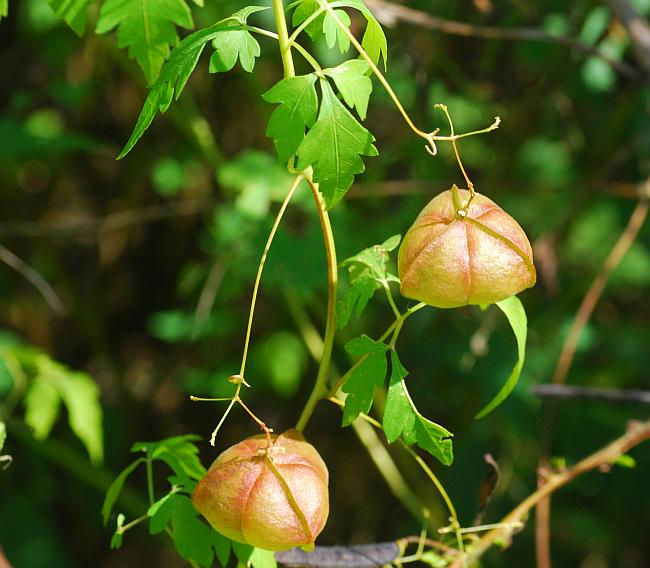Cardiospermum halicacabum L.
Common Balloon Vine

Introduced
CC = *
CW = 0
MOC = 9
© SRTurner
Cardiospermum halicacabum L.Common Balloon Vine | |
 |
Introduced CC = * CW = 0 MOC = 9 |
© SRTurner |
|
Family - Sapindaceae Habit - Annual vine with tendrils. Stems - Vining, climbing, branched, to 4 m, with axillary tendrils.
Leaves - Alternate, once or twice ternately compound, short to long petiolate. Leaflets coarsely toothed or pinnately few-lobed, sparsely pubescent.
Inflorescence - Small axillary panicles, long-stalked, the stalk with a pair of tendrils near its midpoint, the branches and stalks glabrous or sparsely and minutely hairy.
Flowers - Zygomorphic, hypogynous, stalked. Calyces deeply 4-lobed, the lobes oblong to oblong-obovate, usually persistent but inconspicuous and withered at fruiting. Corollas of 4 free petals, 2.5-3.5 mm long, white, with a petaloid appendage surrounding the stamens and ovary. Stamens 8, somewhat exserted beyond the petal appendages, the anthers yellow. Pistil of 3 fused carpels, 3-locular, with 1 ovule per locule. Style 1, slightly exserted at flowering, the stigma deeply 3-lobed.
Fruits - About 4 cm diameter, shallowly 3-lobed, greatly inflated and air filled, with papery walls, green turning to red-brown at maturity, 3-locular, usually 3-seeded. Seeds nearly spherical, smooth, glabrous, black at maturity with a well-developed and sharply delineated white aril, this heart- or kidney-shaped.
Flowering - July - September. Habitat - Open, moist disturbed areas. Origin - Native to Old and New World tropical regions. Lookalikes - None. Other info. - This curious species is not common in Missouri, being found mostly in counties bordering the Mississippi River. When in fruit it is easily recognized by the inflated pillowy balloons (fruits), whose ornamental value have prompted the plant's inclusion in gardens. The attractive seeds have also been used in jewelry. The plants have been used medicinally, as an emetic and laxative, and to treat rheumatoid arthritis. Though not particularly troublesome in Missouri, the species is considered a pest in areas of the southeastern U.S. Photographs taken at Marais Temps Clair Conservation Area, St. Charles County, MO, 9-23-2010 and 8-17-2012 (SRTurner). |